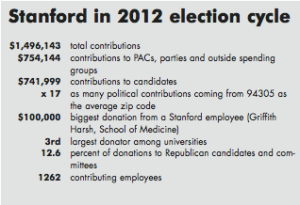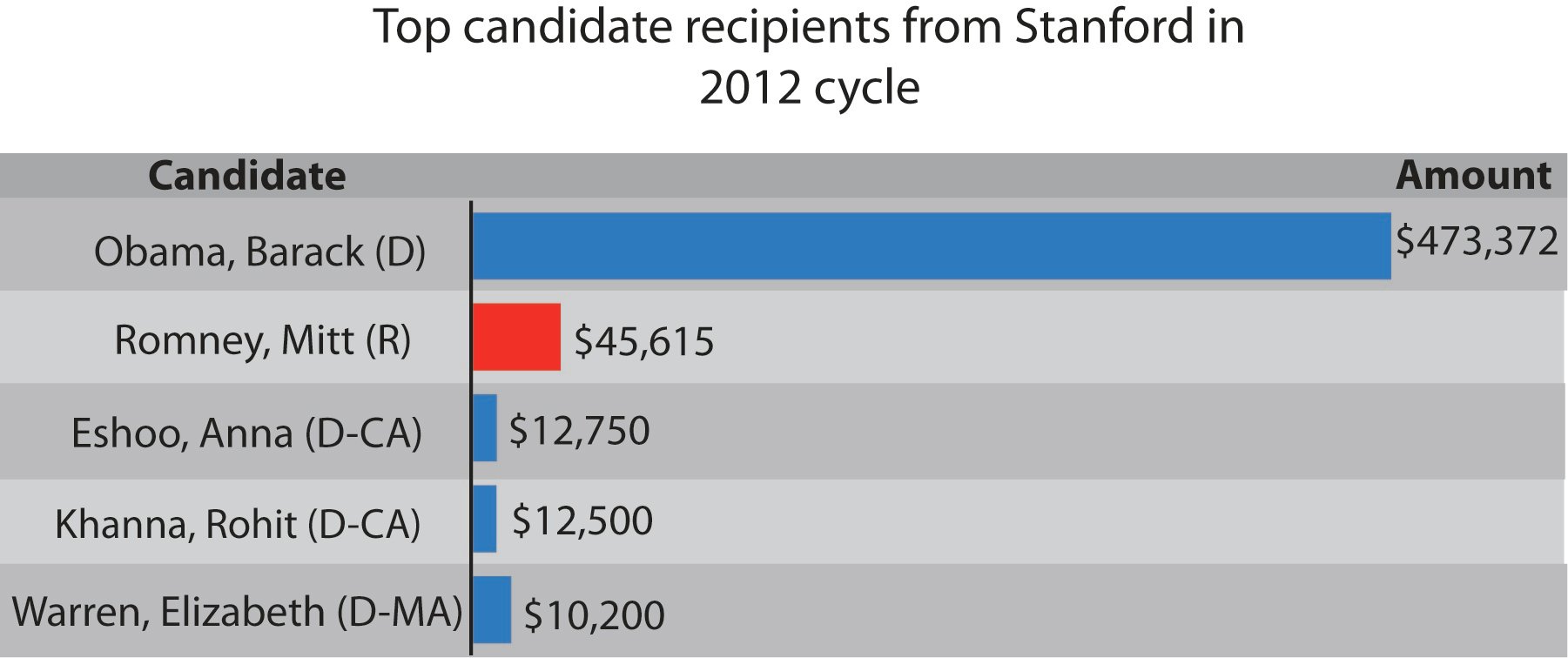With the 2012 presidential election just four days away, many Stanford University employees have already voted with their wallets—most offering support for President Barack Obama’s bid for a second term.
Stanford donors have given a total of $473,372 to Obama’s reelection campaign through Oct. 25, according to Federal Election Commission (FEC) filings. Contributions to Governor Mitt Romney’s campaign from Stanford employees over the same period total only $45,615, a little under 10 percent of the Obama total.
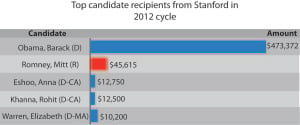
Data courtesy of the Center for Responsive Politics)
These individual contribution figures only represent contributions made directly to presidential campaigns by donors who reported working for Stanford University. Only donations over $200 are tallied.
According to the Center for Responsive Politics, Stanford employees constitute the seventh-largest group of donors to Obama in the 2012 electoral cycle and the third-largest among universities, behind only Harvard and the University of California system.
“This [imbalance in support] is very typical of universities,” said Adam Bonica, associate professor of political science. “Academics also have a high propensity to give, compared to other professionals.”
Obama’s 2012 fundraising totals from Stanford employees, however, are lower than in 2008, when he received $595,716. Larry Diamond ‘73 M.A. ‘78 Ph.D. ‘80, a Hoover Institution senior fellow who has donated $1,250 in the 2012 cycle to Obama, framed the decrease in donor enthusiasm as reflective of 2008’s unique circumstances.
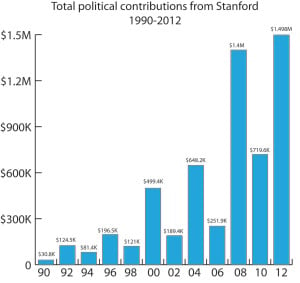
Data courtesy of the Center for Responsive Politics
“2008 was quite exceptional and extremely unlikely to be repeated in enthusiasm or scale,” Diamond said. “A lot of faculty who are somewhere between left and moderate are sure to have disappointments with Obama.”
Diamond said his continued support for Obama emanates largely from the hope that he’ll continue the work of his first term, citing the electoral slogan that “Osama Bin-Laden is dead, and General Motors is alive,” while turning to address issues like the federal deficit and climate change.
“When you look at his accomplishments, they’ve been significant,” Diamond argued.
Keith Hennessey ‘90, a Graduate School of Business lecturer who has donated the maximum individual contribution of $5,000 to Romney, framed his donation as an attempt to address the nation’s current economic struggles and growing national debt.
“I care most about economic policy and have more confidence in both Governor Romney and his economic policy agenda,” Hennessey wrote in a statement.
Hennessey and Diamond both dismissed the notion that faculty involvement in the presidential campaign would have detrimental effects on classroom dynamics.
“You can’t ask faculty to surrender their political views and their sense of responsibility to the country,” Diamond said. “What you can ask faculty to do is to keep their politics out of the classroom, and I’ve tried pretty hard to do that.”
“My professional background is in policy rather than politics,” Hennessey, who was a senior economic adviser to former President George W. Bush, wrote. “I see my goal as making sure students understand a wide range of different approaches to policy, including views with which I strongly disagree.”
Democratic, national leanings
Stanford’s lean towards Democratic candidates extends to candidates further down the ballot as well, as does the fall in enthusiasm from 2008.
Just 12.6 percent of donations from Stanford employees in the 2012 cycle went to Republican candidates and committees, which is less than the 20.9 percent for American universities as a whole but more than Harvard’s 9.9 percent. That 2012 percentage is the second lowest in Stanford’s history since 1980 and is half of the 24 percent given in 2008 to Republicans.
The total amount of donations to federal-level candidates and campaigns has also fallen between 2008 and 2012 from $3,422,293.90 to $2,854,128.60, as did the number of contributing employees, from 1585 to 1262, though both figures could rise in the final week of the campaign.
Bonica framed the historical dominance of federal-level donations (so far this cycle, only $8,503.30 has gone to state or local recipients) as typical of a faculty focus on national issues rather than local concerns, a stance echoed both by Hennessey and by Diamond.
“When it comes to universities, their donations really seem to be tuned into national politics,” Bonica said. “They’re more or less removed from state-level issues…Most giving by university employees is an expression of ideological preference.”
While the Supreme Court’s 2010 Citizens United v. FEC decision has led to a highly contentious increase in corporate involvement in politics, University employees have also been able to take advantage of the ruling, with Griffith Harsh, a School of Medicine professor, providing the largest Stanford employee donation of $100,000 to Restore Our Future, a pro-Romney political action committee. Harsh declined to comment on his donation.
Bonica, however, downplayed the ruling’s significance, noting that affluent individuals have historically had an array of means for funding political activities, such as the Swift Boat Veterans for Truth 527 group of the 2004 presidential election.
“In the past, if you really wanted to give a lot of money, you always had a vehicle to do so,” Bonica said. “They didn’t emerge out of thin air after Citizens United.”
Other Stanford donors, like Carol Winograd, professor emeritus in the School of Medicine, and her husband Terry Winograd, professor emeritus of computer science, gave heavily through accumulated donations to individuals and party committees, amassing over $300,000 in total for Democratic causes.
Even while Stanford employees largely remove themselves from state and local politics, some faculty members remain active in promoting propositions set to appear on the 2012 ballot for California initiatives.
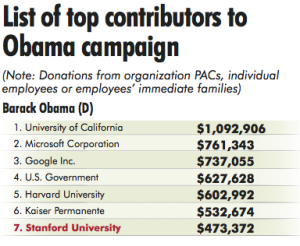
David Mills, senior lecturer at the Law School, said his decision to donate $500,000 to Proposition 36, a movement to amend California’s three-strikes law, emanated from his support for civil rights.
“We can’t continue to imprison people with these extremely lengthy sentences—especially since so many of these people are [people] of color—without there being a great challenge to the fundamental equality of our society,” Mills said.
